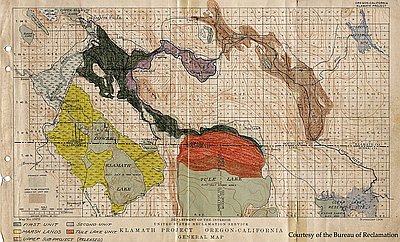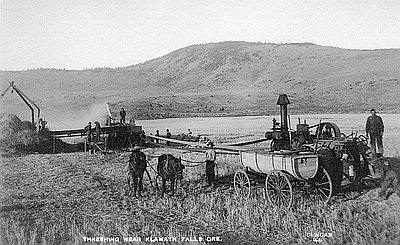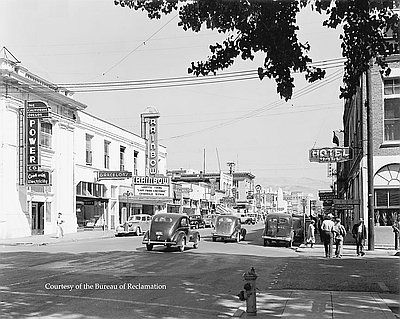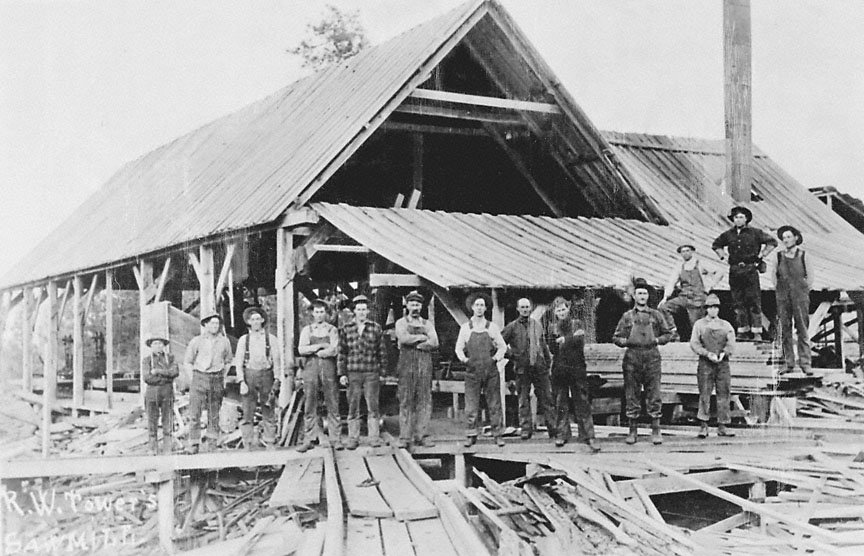- Catalog No. —
- CN 016084
- Date —
- circa 1912
- Era —
- 1881-1920 (Industrialization and Progressive Reform)
- Themes —
- Environment and Natural Resources, Labor, Trade, Business, Industry, and the Economy
- Credits —
- Oregon Historical Society
- Regions —
- Cascades Southwest
- Author —
- F.M. Priest
R.W. Tower Sawmill
These workers take a short break at the R.W. Tower sawmill to pose for this photo, circa 1912. The Tower Mill, located three miles south of Keno, Oregon, was typical of the open-air mills located near cutting sites in the Klamath forests. The average mill of this size hired about 30 people to cut trees, guide logging horses and oxen, care for the horses and oxen, maintain the mill engines, run the saws, and stack the sawn lumber. The mill boss hired the loggers and cooks, purchased food, provided first aid and transportation, and managed the financial books. Turn-of-the-century sawmills were built and later remodeled to adhere to different timber and building demands, and were often dismantled and moved from one location to another depending on the timber supply. Many small sawmills, however, were frequently destroyed by fire.
In 1863, the U.S. Army built the first sawmill in the Klamath Basin across Fort Creek from Fort Klamath. The October 1864 treaty establishing the Klamath Indian Reservation required that the U.S. Government provide the Klamath Tribe a sawmill. The Fort Klamath area was included in the Klamath Reservation and the U.S. Army was ordered to supervise the reservation, so it seems certain that the sawmill was used to comply with the treaty.
Newspaper reports in the 1880s noted that timber supplies in Michigan, Wisconsin, and Minnesota were nearly exhausted. “Lumber capitalists” in Chicago and the Midwest looked to forests in the South and the West to provide raw materials and fill the increasing national demand for lumber. These capitalists found logging easy in the Klamath Basin and Central Oregon because the terrain was flat, which made it easier to transport the logs to mills and the finished wood products to markets throughout the region.
Further Reading:
Lamm, W.E. Lumbering in Klamath. Modoc Point, Oreg., 1944.
Written by Robert Donnelly, © Oregon Historical Society, 2003.
Related Historical Records
-
Klamath Project Map, 1908
At the end of the nineteenth century, the U.S. Government had invested in numerous projects to improve the infrastructure of America. Congress had passed appropriations to fund roads, …

-
Threshing near Klamath Falls
This postcard shows farmers using a steam-powered thresher near Klamath Falls, which was originally called Linkville. In 1909, the Southern Pacific Railroad reached Klamath Falls, helping attract more …

-
Klamath Falls, 1941
In 1860, the Federal Government granted the states swamplands, and by 1867, Oregon opened these lands to settlers. That same year, “swampgrabber” George Nurse secured 160 acres of …

